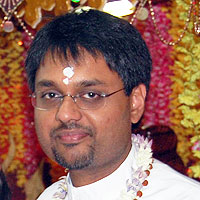From a satsang with Pt. Dr Umesh Persad, Spiritual Leader, SWAHA Gyaan Deepak Kirtan Mandali
The first five Devis discussed in part 1 represent the main principles of creation, which can also be applied to our daily lives as we search for higher spiritual consciousness. The second five Devis represent methods of inner transformation in yoga. They are:
- Chinnamastaa
- Dhoomaavati
- Bagalamukhi
- Maatangi
- Kamala
Chinnamastaa Devi
Chinnamastaa is depicted as holding her severed head in her hands. In Sanskrit, Chinna means ‘to sever’, and mastaa means ‘head’. It is said in the Upanishads, we are what the perceives ourselves to be. It is therefore the cause of bondage as well as liberation. We cannot use the mind to solve this problem because the mind is the cause of our problems. The act of severing the head signifies the elimination of the mind. When the mind stops, only the Self remains. Thus, in order to realise our divinity, we must give up our sense of individual consciousness. How do we eliminate the mind? Mano laya is the temporarily settled state of mind such as deep sleep, whereas mano nasha is the recognition that the mind is false and it dissolves. The key method is self-enquiry; we must not run after our thoughts but enquire as to the source of the thoughts. Who am I?
Dhoomaavati Devi
Dhoomaavati means ‘the smoky One’. Smoke represents suffering in the world. The nature of Dhoomaavati is to obscure through smoke, but She also reveals through fire. In other words, She obscures the unreal and reveals the real. Suffering in life causes us to turn inward; it develops within us an attitude of learning from suffering. Dhoomaavati also represents the void, the imperturbable eye in the midst of the storm. She is the state of equipoise, of remaining calm despite life’s circumstances.
Bagalamukhi Devi
Bagalamukhi in Sanskrit means ‘a restraint for the mouth’ or ‘silence’. The goal is moving beyond our minds. The first practice is keeping the body still, the second is silence of speech and the third is slowing down the breath through the practice of pranayama (breath control). In order to quieten the mind, we must practise looking at our thoughts as they rise and go from the mind.
Maatangi Devi
Maatangi is the opposite of Her predecessor, as her name means ‘expression’. She is known as the tantric Saraswati. She is the expression of sound in the form of music, literature, art and dance. These artforms allow us to become instruments of the divine expression and lead us to the Supreme state.
Kamala Devi
Kamala means ‘She who wears the waters’. She is the Tantric equivalent to Lakshmi Devi. She is the Goddess of light. Her name also means ‘lotus flower’, which is surrounded by water yet blooming. The lotus is a symbol of unfolding spirituality. Thus, She represents spiritual wealth; the beauty of consciousness, life and peace. She is the opposite of Dhoomavati. The practice is samaadhaan, which means focusing on the peace in the self and practising contentment.
These manifestations of the Divine Energy reflect the dynamic unity of existence in which all aspects of life, the purest, the forceful and the inert, are combined to form a whole and diverse vision of the Supreme Reality. By practising the techniques inherent in the representation of each Devi, we can transcend these physical and mental limitations and rediscover our innate divinity.



